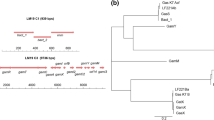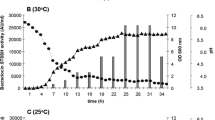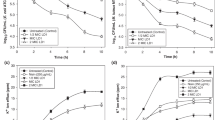Abstract
Lactobacillus acidophilus DSM 20079 is the producer of a novel bacteriocin termed acidocin D20079. In this paper, mode of action using three various concentrations of acidocin D20079 (2,048, 128 and 11.3 AU/ml) was determined against an indicator strain L. delbrueckii subsp. lactis DSM 20076. These concentrations all led to marked decreases in both the number of viable cells and in optical density, indicating that the activity of the acidocin D20079 was bactericidal with concomitant cell lysis. Moreover, the probiotic potential of L. acidophilus DSM 20079 was analyzed for its ability to survive and retain viability at conditions (acid and bile concentrations) mimicking the gastrointestinal (GI) tract, under which it survived exposure to pH 2.0 with a 1.2 log cycle reduction in viability and where 45% of the original population survived in a medium containing 0.3% bile for 3 h.


Similar content being viewed by others
References
Eijsink VGH, Axelsson L, Diep DB, Havarstein LS, Holo H, Nes IF (2002) Production of class II bacteriocins by lactic acid bacteria, an example of biological warfare and communication. Antonie Van Leeuwenhoek 81:639–654
Chen H, Hoover DG (2003) Bacteriocins and their food applications. Compr Rev Food Sci Food Safety 2:82–100
De Vuyst L, Vandamme EJ (1994) Antimicrobial potential of lactic acid bacteria. In: De Vuyst L, Vandamme EJ (eds) Bacteriocins of lactic acid bacteria, microbiology, genetics and applications. Blackie Academic and Professional, Glasgow, pp 91–141
Montville TJ, Winkowski K (1997) Biologically based preservation systems and probiotic bacteria. In: Doyle MP, Beuchat LR, Montville TJ (eds) Food microbiology. Fundamentals and frontiers. ASM press, USA, pp 557–576
Luchansky JB (1999) Overview in applications for bacteriocin-producing lactic acid bacteria and their bacteriocins. Antonie Van Leeuwenhoek 76:335–335
Hammes WP, Weiss N, Holzapfel W (1991) The genera Lactobacillus and Carnobacterium. In: Balows A, Truper HG, Dworkin M, Harder W, Schleifer K-H (eds) The prokaryotes, vol II, 2nd edn. Springer, Heidelberg, pp 1535–1594
Salminen S, Deighton MA, Benno Y, Gorbach SL (1998) Lactic acid bacteria in health and disease. In: Salminen S, Von Wright A (eds) Lactic acid bacteria: microbiology and functional aspects, 2nd edn. Marcel Dekker Inc, New York, pp 211–253
Adams MR (1999) Safety of industrial lactic acid bacteria. J Biotechnol 68:171–178
Saarela M, Mogensen G, Fonden R, Matto J, Mattila-Sandholm T (2000) Probiotic bacteria: safety, functional and technological properties. J Biotechnol 84:197–215
Naidu AS, Bidlack WR, Clemens RA (1999) Probiotic spectra of lactic acid bacteia. Crit Rev Food Sci Technol 38:13–126
Kitazawa H, Ino T, Kawai Y, Itoh T, Saito T (2002) A novel immunostimulating aspect of Lactobacillus gasseri: induction of ‘Gasserokine’ as chemoattractants for macrophages. Int J Food Microbiol 77:29–38
Kaur IP, Chopra K, Saini A (2002) Probiotics: potential pharmaceutical applications. Eur J Pharm Sci 15:1–9
Martensson O, Oste R, Holst O (2002) The effect of yoghurt culture on the survival of probiotic bacteria in oat-based, non dairy products. Food Res Int 35:775–784
Deraz S, Karlsson NE, Hedström M, Andersson MM, Mattiasson B (2005) Purification and characterisation of acidocin D20079, a bacteriocin produced by Lactobacillus acidophilus DSM20079. J Biotechnol 117:343–354
Barefoot SF, Klenhammer TR (1983) Detection and activity of lactacin B, a bacteriocin produced by Lactobacillus acidophilus. Appl Environ Microbiol 45:1808–1815
Parente E, Brienza C, Moles M, Ricciardi A (1994) A comparison of methods for the measurement of bacteriocin activity. J Microbiol Meth 22:95–108
Mataragas M, Metaxopoulos J, Drosinos HE (2002) Characterization of two bacteriocins produced by Leuconostoc mesenteroides L124 and Lactobacillus curvatus L 442, isolated from dry fermented sausages. World J Microbiol Biotechnol 18:847–856
Charteris PW, Kelly MP, Morelli L, Collins KJ (1998) Development and application of an in vitro methodology to determine the transit tolerance of potentially probiotic Lactobacillus and Bifidobacterium species in the upper human gastrointestinal tract. J Appl Microbiol 84:759–768
Matijasic BB, Rogelj I (2000) Lactobacillus K7—a new candidate for a probiotic strain. Food Technol Biotechnol 38:113–119
Gilliland ES, Stalely ET, Bush JL (1984) Importance of bile tolerance of Lactobacillus acidophilus used as dietary adjunct. J Dairy Sci 67:3045–3051
Cintas LM, Casaus MP, Herranz C, Nes IF, Hernandez PE (2001) Bacteriocins of lactic acid bacteria. Food Sci Technol Int 7:281–305
Bierbaum G, Sahl HG (1991) Induction of autolysis Staphylococcus simulans 22 by Pep 5 and nisin and influence of the cationic peptides on the activity of the autolytic enzymes. In: Jung G, Sahl HG (eds) Nisin and novel lantibiotics. Escom Publishers, Leiden, pp. 386–396
Maisnier-Patin S, Forni E, Richard J (1996) Purification, partial characterization and mode of action of enterococcin EFS2, an antilisterial bacteriocin produced by a strain of Enterococcus faecalis isolated from cheese. Int J Food Microbiol 30:255–270
Brock TD (1974) Biology of microorganisms, 2nd edn. Prentice-Hall, Englewood Cliffs
Jack RW, Tagg JR, Ray B (1995) Bacteriocins of gram-positive bacteria. Microbiol Rev 59:171–200
Holzapfel WH, Haberer P, Snel J, Schillinger U, Huis in’t Veld JHJ (1998) Overview of gut flora and probiotics. Int J Food Microbiol 41:85–101
Conway LP, Gorbach LS, Goldin RB (1987) Survival of lactic acid bacteria in the human stomach and adhesion to intestinal cells. J Dairy Sci 70:1–12
Prasad J, Gill H, Smart J, Gopal KP (1998) Selection and characterization of Lactobacillus and Bifidobacterium strains for use as probiotics. Int Dairy J 8:993–1002
Acknowledgments
Mubarak City for Science and the Egyptian Ministry of Scientific Research are gratefully acknowledged for supporting the PhD project of Sahar Deraz ,and her stay at the Deparment of Biotechnology, Lund University. Special thanks for World Laboratory for additional support of the current study.
Author information
Authors and Affiliations
Corresponding author
Rights and permissions
About this article
Cite this article
Deraz, S.F., Karlsson, E.N., Khalil, A.A. et al. Mode of action of acidocin D20079, a bacteriocin produced by the potential probiotic strain, Lactobacillus acidophilus DSM 20079. J Ind Microbiol Biotechnol 34, 373–379 (2007). https://doi.org/10.1007/s10295-007-0206-8
Received:
Accepted:
Published:
Issue Date:
DOI: https://doi.org/10.1007/s10295-007-0206-8




